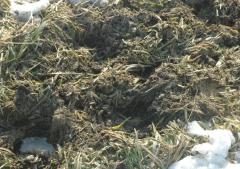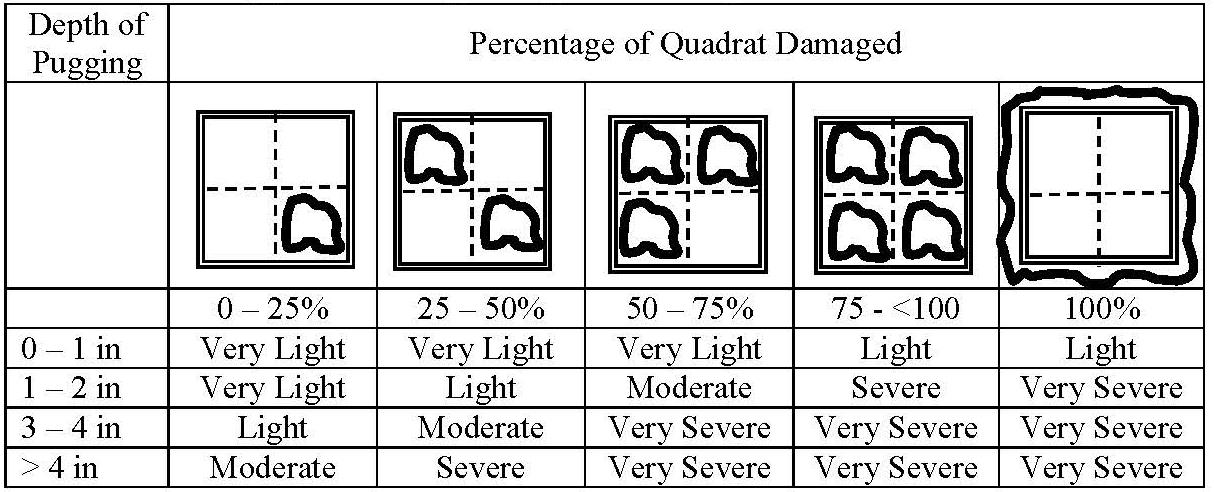Strategies for Repairing Pugged Pastures
By Chris Teutsch, UK Grain and Forage Center of Excellence at Princeton
 Wet conditions can result in significant pugging damage in pastures. Pugging occurs when the hooves of grazing livestock penetrate the soil surface during wet conditions, causing damage to pasture plants as well as soil structure. Pasture plants can be torn and buried. Soils can be compacted, resulting in lower water infiltration rates and increased runoff from pastures. The net result is decreased pasture productivity. Depending on the severity of the damage, decreases in pasture productivity can range from 20-80% for 6 to 12 months following the initial damage. Damaged sods are much more vulnerable to invasion from less productive weedy species. Even after pastures have appeared to recover, pasture productivity can be decreased by as much as 20%. Due to the lower productivity of severely pugged pastures, timely rehabilitation is necessary. The remainder of this article will discuss some options for rejuvenating damaged pastures.
Wet conditions can result in significant pugging damage in pastures. Pugging occurs when the hooves of grazing livestock penetrate the soil surface during wet conditions, causing damage to pasture plants as well as soil structure. Pasture plants can be torn and buried. Soils can be compacted, resulting in lower water infiltration rates and increased runoff from pastures. The net result is decreased pasture productivity. Depending on the severity of the damage, decreases in pasture productivity can range from 20-80% for 6 to 12 months following the initial damage. Damaged sods are much more vulnerable to invasion from less productive weedy species. Even after pastures have appeared to recover, pasture productivity can be decreased by as much as 20%. Due to the lower productivity of severely pugged pastures, timely rehabilitation is necessary. The remainder of this article will discuss some options for rejuvenating damaged pastures.
Assess pugging damage. The first step in developing a recovery strategy is to get an accurate assessment of the severity of pugging damage. In many cases, pugging may not be as bad as it appears at first glance. Frank Mickan from Victoria’s Dairy Extension Centre said it is important to avoid a quick emotionally based assessment. He developed a chart to help quantify pugging damage in pastures. This chart considers the percent of a given area that is damaged and the depth of the pugging damage. He suggests assessing several relatively small areas (1x1 ft) that are representative of the pugging damage that is present. This is best done by making a quadrant out of PVC pipe and laying it on the damaged areas that are being assessed. Then estimating how much of the total area of the paddock has been impacted. Pastures that have very light to light damage may recover fully without any inputs other than extra rest in the spring. Pastures with moderate damage may be thickened up by harrowing to level and smooth damaged areas, broadcasting seed, and cultipacking. Areas with severe and very severe damage will in most cases require full renovation.
Table 1. Assessing pasture damage using an area x depth matrix.

Soil test and adjusting fertility. Damaged areas should be soil tested and lime and fertilizer applied as needed. Soil fertility is a major factor impacting pasture productivity in the Upper South. Poor fertility limits pasture growth and decreases legume presence. In addition, it results in weak sods that are more vulnerable to weed invasion. The best defense against weeds in pastures is maintaining a healthy and vigorous sod.
Rest and recovery. In cases where the pugging damage was very light or light, simply giving pastures a little TLC this spring may be enough. Allow damaged paddocks to get a little more mature before initiating grazing in the spring and give them a little longer rest period after grazing. Make sure to avoid overgrazing these pastures during the summer months when they are stressed by high temperatures and drought.
Subsoiling and surface tillage. Subsoiling may in some cases have a beneficial impact on soil structure, but it has not been shown to consistently increase dry matter production of pastures. Likewise, surface tillage (harrowing, disking, etc.) alone has been shown to have limited impact on overall dry matter production. Both practices have no impact or in some cases may further damage recovering plants. In either case, pasture sods still have a decreased stand density, making them vulnerable to invasion by undesirable weedy species.
Overseeding damaged sods. Pugging may provide an excellent opportunity to incorporate legumes and improved grass species into tall fescue sods. Damaged sods may be overseed with legumes or a combination of grasses and legumes. This is best accomplished in late winter or early spring. Areas should be leveled with a pasture drag or other tillage implement, and seed can then be broadcast on the soil surface and cultipacked. A legume mixture that works well across the Commonwealth is 6-8 lb/A red clover + 1-2 lb/A ladino clover. Grass can also be added to this mixture as needed. Tall fescue can be broadcast at a rate of 10-15 lb/A and orchardgrass at 6-8 lb/A. If summer forage is needed, the damaged area may be prepared as described above and overseed in mid- to late April with a mixture of crabgrass (3-6 lb/A) and annual lespedeza (10-15 lb/A).
Reseeding damaged sods. In cases of severely and very severely pugged sods, complete renovation may be needed. Although sods can be reseeded in the spring, it may be advisable to wait until the following fall. In this case, severely damaged areas can be leveled and smoothed by harrowing in late spring and seeded with a summer annual crop such as pearl millet or sorghum-sudangrass. These crops can be utilized for summer grazing or conserved as hay or silage. This provides the opportunity to adjust soil fertility as needed and control any undesirable plant species with a nonselective herbicide application in late spring and again in late summer before reseeding the desired perennial forage mixture. This is an ideal opportunity to eliminate toxic tall fescue from a paddock and reseed a novel endophyte tall fescue variety. For more information on converting from toxic to novel endophyte tall fescue, watch videos from the tall renovation workshop that was held last spring in Lexington at KYForages on YouTube.
The best solution to pugging damage is to work hard at avoiding it. This may not always be possible, but there are some strategies that you can implement when blessed with a little more water than we can use at any given time. The first strategy is to keep the cattle moving. This will help keep them from damaging any one paddock severely. The second is to just select a paddock that needs renovated and let them camp out there with some hay until things dry up. This second option has some issues in that animals may likely be in the middle of a mucky mess and that is not good for animal health and you must feed hay.
For more information on renovating pastures and no-till seeding techniques, visit UK Forage Extension or contact your local extension office.
Categories:
Spring
Establishment/Renovation


